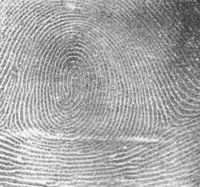Palm print
From Wikipedia, the free encyclopedia
| Forensic science |
|---|
 |
| Physiological sciences |
|
| Social sciences |
| Forensic criminalistics |
| Digital forensics |
|
| Related disciplines |
| People |
| Related articles |
A palm print refers to an image acquired of the palm region of the hand. It can be either an online image (i.e. taken by a scanner, or CCD) or offline image where the image is taken with ink and paper .
The palm itself consists of principal lines, wrinkles (secondary lines) and epidermal ridges. It differs to a fingerprint in that it also contains other information such as texture, indents and marks which can be used when comparing one palm to another.
Palm prints can be used for criminal, forensic or commercial applications. Palm prints, typically from the butt of the palm, are often found at crime scenes as the result of the offender's gloves slipping during the commission of the crime, and thus exposing part of the unprotected hand.[1]
- ↑ Fisher, Barry A.J. Techniques of Crime Scene Investigation. Boca Raton, CRC Press. 2004. ISBN 0-8493-1691-X
References
- ^ Zhang, D. (2004). ‘’Palmprint Authentication’’, Kluwer Academic Publishers.
This article is issued from Wikipedia. The text is available under the Creative Commons Attribution/Share Alike; additional terms may apply for the media files.